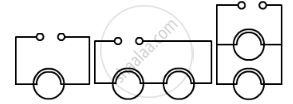Advertisements
Advertisements
Question
Two electric bulbs rated 100 W; 220 V and 60 W; 220 V are connected in parallel to electric mains of 220 V. Find the current drawn by the bulbs from the mains.
Solution

Firstly calculating the resistance of the electric bulbs,
P=`"V"^2/"R"`
⇒ `"R"="V"^2/"P"`
⇒ `"R"_1 =220^2/100 =484 Ω`
⇒ `"R"_2=220^2/60=2420/3 Ω`
`"R"_"eq" = ("R"_1"R"_2)/("R"_1+"R"_2)=(484xx(2420//3))/(484+(2420//3))=302.5Ω`
Total current drawn by the bulbs from the mains supply,
`"I"=220/302.5=0.73 "A"`
APPEARS IN
RELATED QUESTIONS
In which direction do electrons flow?
The p.d. across a 3 Ω resistor is 6 V. The current flowing in the resistor will be:
(a) `1/2A`
(b) 1 A
(c) 2 A
(d) 6 A
The circuit diagram given below shows the combination of three resistors R1, R2 and R3:

Find :
(i) total resistance of the circuit.
(ii) total current flowing in the circuit.
(iii) the potential difference across R1.
Consider the circuit given below:

(a) In which circuit are the lamps dimmest?
(b) In which circuit or circuits are the lamps of equal brightness to the lamps in circuit (i)?
(c) Which circuit gives out the maximum light?
An electrician has wired a house in such a way that if a lamp gets fused in one room of the house, all the lamps in other rooms of the house stop working. What is the defect in the wiring?
Distinguish between an open and a closed circuit.
What would be the danger involved in replacing a blown fuse with the one which would carry a large current?
Name the principle on which a transformer works.
Small amounts of electrical current are measured in milliampere (mA). How many milliampere are there in 0.25 A ?
The SI unit for electric current is the coulomb.
